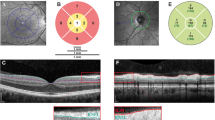Abstract
Background
Adrenoleukodystrophy (ALD) encompasses different neurological phenotypes, ranging from the most severe cerebral forms (C-ALD) to the less severe adrenomyeloneuropathy (AMN). As visual system can be varyingly involved, we aimed at exploring whether optical coherence tomography (OCT) may detect retinal abnormalities and their longitudinal changes in adult ALD patients.
Methods
In this cross-sectional and longitudinal study, we measured the thicknesses of peripapillary retinal nerve fiber layer (pRNFL), macular ganglion cell complex (mGCC), and segmented inner and outer macula at baseline and their changes over time in 11 symptomatic adult ALD males and 10 age- and sex-matched healthy controls. Statistical analyses were performed for the patients as complete group, and splitting them into two subgroups, one (C-ALD) with and the other (AMN) without cerebral parieto-occipital white matter (WM) lesions.
Results
In the complete ALD group and in the C-ALD subgroup, the average pRNFL, mGCC, and inner macula were significantly thinner than in controls (p ≤ 0.01), whereas in the AMN subgroup, they were constantly, though non-significantly, thinner. Significant outer macula thinning was also observed (p < 0.01). In the complete ALD group, follow-up assessment (mean 26.8 months, range 8–48) showed mildly progressive thinning of inferior pRNFL, average mGCC, and inner macula.
Conclusions
In adult ALD patients, OCT can reveal retinal abnormalities which are prominent in the more compromised patients, namely those with parieto-occipital WM lesions. The inferior pRNFL, average mGCC and inner macula thicknesses might be sensitive-to-change OCT parameters, but their utility and consistency for short-term longitudinal studies deserve further investigations.
Similar content being viewed by others
References
Engelen M, Kemp S, de Visser M, van Geel BM, Wanders RJ, Aubourg P, Poll-The BT (2012) X-linked adrenoleukodystrophy (X-ALD): clinical presentation and guidelines for diagnosis, follow-up and management. Orphanet J Rare Dis 7:51
Carmant L, Décarie JC, Fon E, Shevell MI (1998) Transient visual symptoms as the initial manifestation of childhood adrenoleukodystrophy. Pediatr Neurol 19:62–64
Powers JM (1985) Adreno-leukodystrophy (adreno-testiculo-leukomyelo-neuropathic-complex). Clin Neuropathol 4:181–199
Kaplan PW, Kruse B, Tusa RJ, Shankroff J, Rignani J, Moser HW (1995) Visual system abnormalities in adrenomyeloneuropathy. Ann Neurol 37:550–552
Aquino JJ, Sotirchos ES, Saidha S, Raymond GV, Calabresi PA (2013) Optical coherence tomography in X-linked adrenoleukodystrophy. Pediatr Neurol 49:182–184
Ohkuma Y, Hayashi T, Yoshimine S, Tsuneoka H, Terao Y, Akiyama M, Ida H, Ohashi T, Okumura A, Ebihara N, Murakami A, Shimozawa N (2014) Retinal ganglion cell loss in X-linked Adrenoleukodystrophy with an ABCD1 mutation (Gly266Arg). Neuroophthalmology 38:331–335
Grainger BT, Papchenko TL, Danesh-Meyer HV (2010) Optic nerve atrophy in adrenoleukodystrophy detectable by optic coherence tomography. J Clin Neurosci 17:122–124
van Ballegoij WJC, Kuijpers SC, Huffnagel IC, Weinstein HC, Poll-The BT, Engelen M, Bennebroek CAM, Verbraak FD (2019) Optical coherence tomography shows neuroretinal thinning in myelopathy of adrenoleukodystrophy. J Neurol 267:679–687. https://doi.org/10.1007/s00415-019-09627-z
Huang J, Huang J, Chen Y, Ying GS (2018) Evaluation of approaches to analyzing continuous correlated eye data when sample size is small. Ophthalmic Epidemiol 25:45–54
Violating the normality assumption may be the lesser of two evils | bioRxiv. https://www.biorxiv.org/content/10.1101/498931v2.full. Accessed 11 Jun 2020
Avery RA, Cnaan A, Schuman JS, Trimboli-Heidler C, Chen CL, Packer RJ, Ishikawa H (2015) Longitudinal change of circumpapillary retinal nerve fiber layer thickness in children with optic pathway Gliomas. Am J Ophthalmol 160:944–952.e1
Cleophas TJ, Zwinderman AH (2012) Mixed linear models for repeated measures. In: Statistics applied to clinical studies. Springer Netherlands, Dordrecht, pp 593–605
Loes DJ, Hite S, Moser H, Stillman AE, Shapiro E, Lockman L, Latchaw RE, Krivit W (1994) Adrenoleukodystrophy: a scoring method for brain MR observations. AJNR Am J Neuroradiol 15:1761–1766
Cohen SM, Green WR, de la Cruz ZC, Brown FR 3rd, Moser HW, Luckenbach MW, Dove DJ, Maumenee IH (1983) Ocular histopathologic studies of neonatal and childhood adrenoleukodystrophy. Am J Ophthalmol 95:82–96
Leite MT, Rao HL, Weinreb RN, Zangwill LM, Bowd C, Sample PA, Tafreshi A, Medeiros FA (2011) Agreement among spectral-domain optical coherence tomography instruments for assessing retinal nerve fiber layer thickness. Am J Ophthalmol 151:85–92.e1
Funding
This study was partially funded by the Italian Ministry of Health (Current Research Funds and grant RF-2016-02361285).
Author information
Authors and Affiliations
Corresponding author
Ethics declarations
Conflict of interest
The authors declare that they have no conflict of interest.
Ethical approval
This study was performed as per local ethics committee-approved guidelines in accordance with the Declaration of Helsinki principles, and all the involved patients gave their written informed consent..
Additional information
Publisher’s note
Springer Nature remains neutral with regard to jurisdictional claims in published maps and institutional affiliations.
Rights and permissions
About this article
Cite this article
Bianchi-Marzoli, S., Fenu, S., Melzi, L. et al. Optical coherence tomography in adult adrenoleukodystrophy: a cross-sectional and longitudinal study. Neurol Sci 42, 235–241 (2021). https://doi.org/10.1007/s10072-020-04576-2
Received:
Accepted:
Published:
Issue Date:
DOI: https://doi.org/10.1007/s10072-020-04576-2




